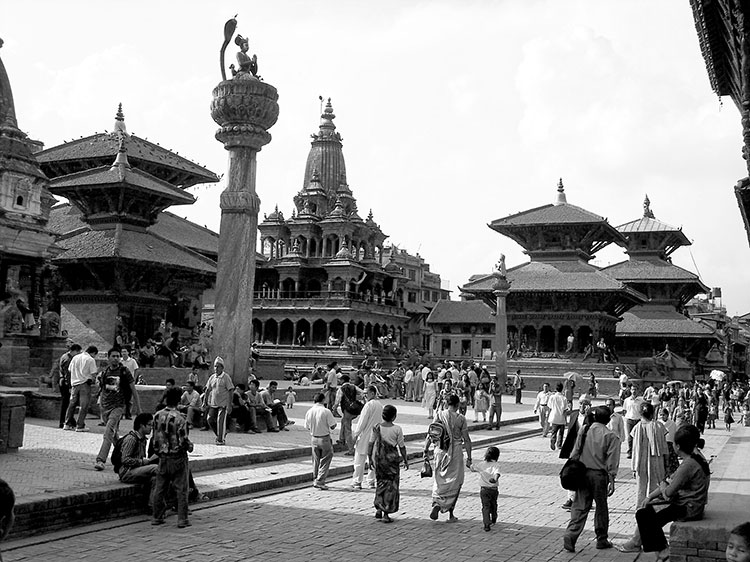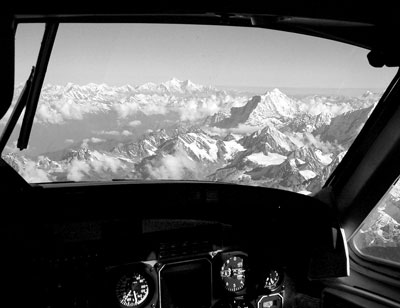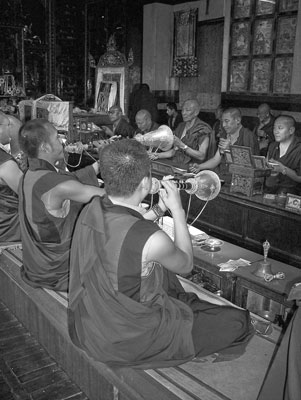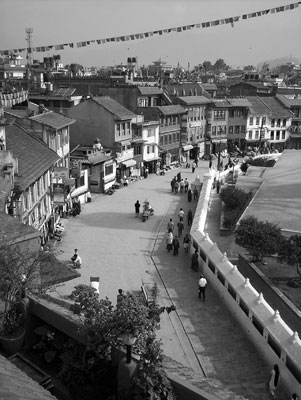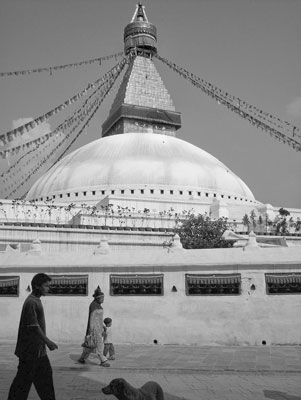Nepal excursion
This item appears on page 78 of the December 2008 issue.
(4 of 4 on India plus Nepal)
Kathmandu
During the latter part of my May 2008 visit to India, I had the chance to experience the Kathmandu Valley region of exotic Nepal. My short trip focused on some of Nepal’s prime historic locations, including several UNESCO World Heritage Sites. Those who have more time likely would be well rewarded by venturing farther afield to some of Nepal’s rural cultural destinations. Seasonal hiking and walking tours of various grades abound.
Everest soaring
Why go to Nepal without seeing Mt. Everest up close, especially when it is possible to do so on a one-hour, early-morning excursion flight ($170)?
Aboard a Buddha Air 16-seater, we quickly climbed above the clouds to survey the highest stretch of the Himalayas and its crown jewel, Mt. Everest. Our pilot made a sufficient number of passes to insure that passengers on both sides of our aircraft had equally unobstructed views.
Additionally, we each were allowed into the cockpit for viewing and photo ops. My photos came out exceptionally well, highlighting this all-too-quick, once-in-a-lifetime adventure. We were advised that while flights are subject to weather conditions, if planes do take off then clear viewing is assured.
Kathmandu touring
A highlight of my first day of touring Kathmandu was Bodhnath, the largest stupa in all of Nepal and certainly one of the most colorful. The 17th-century complex has a decidedly Tibetan Buddhist influence and, to my mind, a very inviting sense of light and positive energy. Many Tibetans escaped to this area in the 1960s when Tibet was invaded by China.
Next was Patan, “City of Beauty and Fine Art,” dating to AD 289 and known as the center of Newari Architecture. It features hundreds of ornate temple edifices, the temples dedicated to an array of Hindu and Buddhist gods. Patan is a well-maintained mini-city within a city and can be enjoyed on a leisurely walking excursion.
Our final stop of the day was hilltop Swayambhunath, or “Eye of the Buddha,” which is estimated to be over 2,000 years old. The area around the main stupa is adorned with smaller stupas, temples and terraces, providing sweeping views over Kathmandu City and surrounds. The setting is meditatively inviting, making the site a favored gathering spot for locals.
More wanderings
On the morning of my final full day in Nepal we visited the center of Kathmandu city.
The focal point is Durbar Square, where the largest grouping of palaces and temples is found. Overlooking the square is imposing Hanuman Dhoka Palace, and a short walk away is the Temple of Kumari, whose central courtyard is open to visitors.
Outside the city and en route to Nagarkot, we visited the impeccably restored ancient city of Bhadgaon (founded in AD 889), which is constructed in the shape of a conch shell, an object of religious significance to both Buddhists and Hindus.
The main feature is Pashupatinah, a temple dedicated to Lord Shiva, the destroyer and creator. It is one of the four most noteworthy pilgrimage sites for Hindus in Asia.
During my time in Kathmandu, some of the main roads were closed due to political protests, so our sightseeing routes, of necessity, relied on unpaved back roads, providing the bonus of unexpected exposure to some of Kathmandu’s interesting suburban communities.
Nagarkot — above the clouds
A prime highlight of my time in Nepal was a final afternoon excursion to Nagarkot and the Club Himalaya Resort (www.nepalshotel.com), less than an hour’s drive from Kathmandu City and perched at an elevation of nearly 7,000 feet.
When tourism opened up in Nepal in the 1960s, pre-hotels Nagarkot became a popular day trip for locals and visitors to experience both sunrises and sunsets and, for most of the year, spectacular sweeping views of the snowcapped Himalayas.
From Nagarkot I enjoyed a 45-minute downhill hike through local villages, getting an up-close peek at the locals’ mountainside lifestyle.
Today guests at Club Himalaya enjoy these same views in comfort along with a variety of hiking trails and relaxing resort-based activities. Room rates begin at $80, double. I definitely recommend one or more nights or, at the very least, a day trip to this scenic mountaintop refuge.
Crowne Plaza comfort
In Kathmandu City I was fortunate to be accommodated at the Soaltee Crowne Plaza. About 10 minutes from the city center, this hotel is nestled into manicured gardens on 11 landscaped acres sporting bountiful mountain views.
Residing on the Club Floor includes access to a special lounge featuring complimentary nightly cocktails and fine finger foods, which I enjoyed immensely.
The service and the range of facilities, including three restaurants, were excellent at the Soaltee, and the staff went out of their way to assist with some special requests. On my final evening in Nepal, I was even able to fit in a massage at the downstairs health club at the bargain rate of $20 including tip. Painless!
Before you go. . .
For information on a wide variety of tours and Independent travel to Nepal, India and worldwide, contact my host for this trip, SITA World Tours (16250 Ventura Blvd., Ste. 300, Encino, CA 91436; 800/421-5643, e-mail sitatours@sitatours.com or visit www.sitatours.com).
Keck's Beyond the Garden Wall
❝In the hallowed heights above the clouds,
the fate of the human explorer
is at the will of the gods of nature
Far below these reverent heights,
in mammal-evolved habitat,
the fate of the natural world
is at the will of the ungodly human experiment
Would that these fragile fortunes be reversed ❞
— Randy’s lamenting wish for the future of planet Earth’s fragile environments

